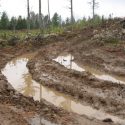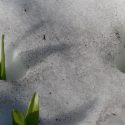Irrigation system manages stormwater
This summer, Doug Soldat is saving for a not-so-rainy day.
The University of Wisconsin–Madison soil scientist is banking rainwater, up to 8,000 gallons of it, enough to keep the lawn at UW–Madison’s O.J. Noer Turfgrass Research and Education Facility lush through the driest weeks of summer.
Soldat and graduate student Brad DeBels installed two 4,000-gallon tanks, like rain barrels on steroids, that collect rainwater from the roof of the turfgrass facility’s main building on Madison’s far west side. Water from those tanks is used to irrigate nearby turf via subsurface drip irrigation lines.
Soldat views the setup as a prototype for a sustainable turfgrass irrigation system that does not rely on wells, water mains, storm drains or the electrical grid.
“In a three-month period we collected 19,000 gallons off the roof at the Noer Center and sent it all to the turf — 3,150 square feet of lawn,” he says. “We were able to use and infiltrate all of the rain that that fell on the Noer Center’s 7,000-square-foot rooftop.”
Systems like this could make a noticeable dent in the amount of water pumped from wells and surface waters. The U.S. Environmental Protection Agency estimates that about a third of the water piped to a typical household is used outdoors, and half of that goes to water lawns and gardens. Having capacity to store large volumes of water and disperse it quickly will serve well if, as climatologists suggest, Wisconsin is seeing a pattern of fewer but larger summer rainstorms.
But Soldat sees it as more than a way to water the lawn without turning on the tap. It’s also a tool for infiltrating more stormwater, preventing runoff that floods and contaminates surface waters, and recharging rapidly depleting groundwater.
“The irrigation lines are buried 10 inches below the surface. By putting them that far down, we’re able to slowly drip water even when the ground is saturated,” he says. “If rain is forecast and our tanks are full, we can disperse the water. So it functions both as an irrigation system for turf and to infiltrate water over a large area over a period of time.”
Dripping the water underground also reduces evaporation, a huge source of water loss in Wisconsin during summer months, and lets the lawn be watered and used at the same time. Major league sports fields use similar systems, allowing irrigation during ballgames.
And putting the water underground reduces the chance of damaging turf and soil by overwatering.
“Last fall in one of our (plots), we put on three and a half inches of water in four hours without any ponding, because all of the water leached through the soil. If you did that with overhead irrigation, you would be putting it on faster than soil could infiltrate. Your lawn would be a muddy mess,” DeBels says.
The subsurface drip system also uses very little energy, which would make it easy to convert to solar power, DeBels adds. “We don’t need a high pressure pump. The water is basically trickling out,” he says. “We could use easily use solar power, either to charge batteries or to run the pumps directly. If we did that, the entire system would be sustainable.”
Converting the system to solar is one of Soldat’s goals. Another is to develop a smaller system for residential use. He estimates that for own his house — about 1,000 square feet of roof and 3,000 square feet of lawn — a 2,000-gallon tank would keep the grass green for at least three weeks. That size of tank could easily be hidden under a deck or porch, he points out.
“Homeowners can do this with rain barrels, but rain barrels are very small compared to the roof area,” he says. “Most of them are 50 gallons. That much comes off a roof in a very small amount of time, and the rest goes to overflow. We have the same concept, but we’re able to store enough water for irrigation to get us through a four- to six-week dry period.”



